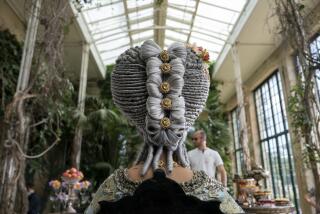Hair chalking: Vibrant color you rub on and go
- Share via
Lauren Conrad’s hairstylist Kristin Ess says she often achieves Conrad’s colorful looks with dye. But Ess has also used another technique on her celebrity client, one perfect for allowing the less emboldened to opt in on the hair hue mania in a decidedly old-school and far less committed way. Hair chalking is just what it sounds like. You buy soft chalk pastels from the craft store and rub them on your hair. It lasts for a day or two or until the next wash.
Tina Dizon, owner of the Private Room salon in Beverly Hills, says hair chalking started as a street style but now shows up on fashion runways.
“What’s great about hair chalking is that it’s completely temporary,” Dizon says. “You put it on, you put on your alter ego, have a fun night out and you can be conservative or not, professional or not, and still change your look within seconds. And then it comes out the next day. It’s so noncommittal.”
This is a technique you can do in a salon or at home — but know that it can be very messy.
“Doing it at home is definitely messier than doing it in the salon. At the Private Room … we have the technique down to a science,” Dizon says. “It’s also fun to come in with a group of your friends and actually have a day of beauty without the expensive check at the end of the day.” Prices start at $10 for a streak and up to $75 for ombre.
Do-it-yourselfers can find instructions online. Ess, for instance, posted instructions on the website she co-founded, TheBeautyDepartment.com, and makeup artist Kandee Johnson has a how-to video at Kandeej.com.
Ess recommends using Sennelier brand soft chalk pastels. (Blick Art Supply https://www.dickblick.com sells sets starting at about $40 and individual colors for less than $6 per piece. If you want to go cheaper, Michael’s sells chalk sets for under $10.) Ess warns not to confuse “soft chalk” pastels with oil pastels. Removing the latter from hair is a pain.
Be sure to wear clothes you don’t mind getting dirty — change into your going-out clothes later, after the messy chalking process is done. Some stylists including Ess recommend wetting your hair with a spray bottle first to make it absorb the pigment better, unless your hair is lighter than dark blond. Lighter hair could become stained and the chalk might be difficult to remove.
Some experts recommend twisting hair before chalking because the texture of twisted hair makes it easier for pigment to stick. And play with different styles. Hair chalking on braids, updos and ponytails looks really pretty and fun.
You can be as wild or mild as you want.
“I have clients who see that their kids are doing it and they want to try it, but without feeling like they’re trying too hard, so we might put just a peek of color at the nape of the neck,” Dizon says. “For brunets we can actually use caramel colors as if they were highlights … whether it’s a caramel-golden highlight or a reddish-copperish highlight.”
Some do-it-yourself videos recommend wetting hair, chalking and then flat ironing the hair to seal in the pigment, but Dizon disagrees. “It kills me because when you put that kind of heat on damp hair it starts to fry it more,” Dizon says. Her technique doesn’t include first using water, Dizon says, because of the high-quality, highly pigmented pastels she uses. “And we don’t use heat on top of the chalking. We style the hair first to see exactly where we want to place the color.”
An exception is for a braid, when she chalks the hair, braids it, then adds even more pigment for vibrancy, finishing with hair spray to keep the style intact. To wash it out, use clarifying shampoo, then condition, condition, condition.






